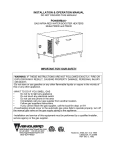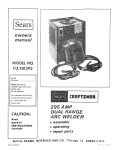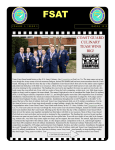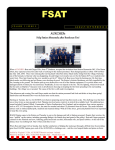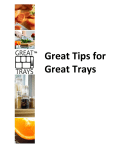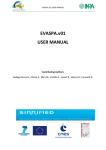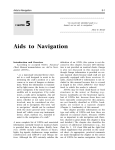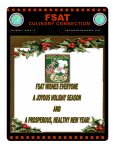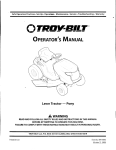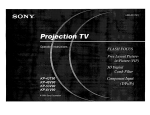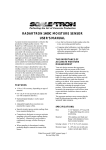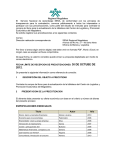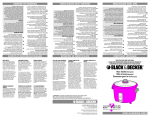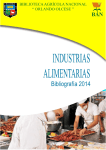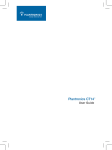Download AUXFS Training and Qualification Guide
Transcript
U.S. Coast Guard Auxiliary National Department of Human Resources AUXFS Training and Qualification Guide Approved by Coast Guard and Coast Guard Auxiliary-- April 2014 This page intentionally blank. Table of Contents Introduction Chapter 1: Overview of the AUXFS Program • History • Goals and benefits • Administrative issues Chapter 2: Coast Guard Food Services Overview Chapter 3: Tools and Equipment • Introduction of the concepts of food and non-food contact surfaces and the various types of food service tools, equipment and utensils used in preparing, holding, serving and storing food Chapter 4: Sanitation and Safety • Instruction on how food becomes unsafe and guidelines for keeping food safe, including personal hygiene. • Instruction for cleaning and sanitizing equipment. • Instruction on knife handling. Chapter 5: Introduction to Food Preparation • Introduction of basic cooking principals, meal planning, recipe conversions, knife skills • Herbs and Spices • Nutrition • Presentation Chapter 6: VIP Events and other AUXFS Duty Chapter 7: Hands-on meal planning, preparation, and serving Chapter 8: Performance Qualification Standards Appendices Resources A. B. C. D. AUXFS Resources AUXFS Uniforms AUXFS Health Record Verification ALCOAST AUXFS PQS and Health Record Verification Forms Introduction This Guide has been developed to provide training to the AUXFSs that is consistent with the training given to the Coast Guard Food Service Specialists. The Guide is based on Food Services Specialist, Third Class Performance Qualification Guide. Auxiliarists who cook at Coast Guard stations, cutters, or VIP events are required to take the AUXFS training. The AUXFS designation demonstrates to the Coast Guard Food Service Specialists that an Auxiliarist has the training and experience necessary to comply with Coast Guard policies and procedures. There are three parts to the AUXFS training: 1. Classroom training of approximately14 hours 2. “Hands-on” training of approximately 8 hours where a meal is planned, prepared, and served. 3. Accomplishment of Performance Qualifications to be performed within one year of completion of AUXFS training and signed off on by an AUXFS mentor or unit Food Service Specialist. References The following references will be used during the training and subsequent AUXFS duty. • • • • • • • AUXFS Training and Qualifications Guide Coast Guard Food Service Manual, COMDTINST M4061.5 (series) Food Service Practical Handbook, COMDTPUB P4061.4 Food Service Sanitation Manual, COMDTINST M6240.4 (series) Auxiliary Manual, COMDTINST M16790.1G Professional Cooking, 7th Edition by Wayne Gisslen Various handouts specified by the National Auxiliary AUXFS Program or the Coast Guard Food Services Program. Chapter 1: Overview of the AUXFS Program History After 9/11, it became obvious that Auxiliarists had many new roles that they could play as part of Team Coast Guard. Auxiliarists had been informally supporting stations and cutters by helping in the galleys. In 2006, through the efforts of District 1SR, the Auxiliary Chef (AUXCHEF) program was approved as a pilot program. District 5SR then spearheaded its development, serving at small boat stations, on cutters, and at VIP events throughout the 5th District. In January 2009, the National Commodore and National Executive Committee approved the AUXCHEF Program as an Auxiliary National Program and this guide was officially adopted in 2010. In 2013, the AUXCHEF program was renamed the AUXFS program to more closely resemble in both name and practice the policies and standards required of active duty Coast Guard Food Service Specialists. Goals of the AUXFS Program • Give Auxiliarists another means to contribute to and support the Gold Side. • Provide simple Food Service training to Auxiliarists. • Relieve the Food Service Specialists (FSs) at small boat stations and cutters so that they can take leave, attend “C” schools or other training, or perform other duties. • Provide assistance at Coast Guard and Auxiliary VIP events. • Provide training and support to Food Service Specialists (FSs). • Improve the morale of Coast Guard personnel. • Demonstrate to the Gold Side the importance and diversity of the Auxiliary. • Support the Coast Guard and Auxiliary in emergencies. • Add to the activities in which Auxiliarists participate, adding interest to their career. This is important to recruiting and retention. Qualifications • A desire to help and support the active duty Coast Guard • Cooking experience not a requirement. • Available time to volunteer. • Completion of the AUXFS Training Program and PQSs, including TCT (if required by the Coast Guard unit they’re supporting) and getting the HEP A vaccination. Be qualified as an Auxiliary instructor in order to be certified as an AUXFS instructor. Duties of AUXFSs Under the supervision of the unit Food Service Officer (FSO) and/or Senior AUXFS, a trained AUXFS will: • Plan meals and shopping lists NOTE: AUXFSS shall not do any direct purchasing, with or without a unit credit card, as this would be a violation of Coast Guard and federal policies and regulations. • Prepare meals • Serve meals • Some clean up Program Administration Structure of the AUXFS Program At the National level, the AUXFS Program will be implemented and administered by AUXFS Division within the National Department of Human Resources. The District Commodore will appoint a District AUXFS Chair. The Chair will be responsible for implementing and administrating the AUXFS Program at the District level. The District Commodore may appoint subordinate chairs/leaders at the Sector, Division, or unit level as needed, in consultation with the District AUXFS Chair. The Director of Auxiliary in each District will support the AUXFS to the extent possible. Assignments o The AUXFS Chair will work with the Sectors to disseminate information on the AUXFS Program to the units. o The Coast Guard unit will request assistance through the District AUXFS Chair who will then ask for AUXFS volunteers in the area and will make the assignment. This task may be delegated to an AUXFS leader at the Sector or Division level. o The AUXFS Chair will consult with the Unit OIC. o Duty time may be from one meal to several weeks depending on the nature and location of the duty and the needs of the unit. o AUXFSs assigned to a cutter must be physically able to handle the duty. The AUXFS Chair or unit OIC will make this determination. Orders Generally the unit being supported will provide them. o The type of orders depends on the duty unit • Non-Reimbursable Orders • Reimbursable Orders • May cover mileage outside the normal commuting area. o Berthing and meals are usually provided by unit, and must be reflected on orders. Health Issues o Hepatitis A Shots are required. The Coast Guard can provide the shots at a Coast Guard health care facility if supplies and operations allow. However, all AUXFS must provide proof of their vaccination in accordance with Appendices C & D. o The AUXFS must be physically able to handle the assignment. Uniform o The ODU is generally the required uniform for AUXFSs working at a Station or on a cutter. However, a Unit may prescribe a different uniform. (See Appendix C for uniform details) o For VIP events, a white chef coat, black pants, and black shoes will be required. There are many sources for inexpensive chef clothing. AUXFS in AUXDATA o AUXFS is a competency in AUXDATA o When an AUXFS completes: • the PQS • is current on TCT (if applicable) and • has had the Hep A vaccination, the AUXFS can be entered into AUXDATA as “Qualified” o The District Chair certifies to the District DIRAUX that the AUXFS meets the requirements and can be entered into AUXDATA. Reporting Time for AUXDATA • • • • • For AUXFS duty at or in support of a Coast Guard Unit o Report time on the 7030 (Mission Activity Report) using Mission Code 07D (CG Operational Support) Put “AUXFS Duty” in the Remarks Section with details of the duty – this allows the IS Officer to enter time under the AUXFS Operational Code) Enter the appropriate OPCON Code Record only the time actually spent on FS/AUXFS duties Record no more than 19 hours per day – unless on a cutter where up to 24 hours can be recorded. For AUXFS duty in support of Auxiliary units o Report the time on the 7029 (Member Activity Log) under 99E (Auxiliary Administrative/Logistical Support) Put “AUXFS Duty” in Mission Description with the details of the duty - this allows the IS Officer to enter time under the AUXFS Operational Code Record only the time actually spent on AUXFS duties Record the AUXFS hours separately from other 99E hours For preparation and travel in support of all AUXFS duties, report these hours on the 7029 (Member Activity Log) under 99B Submit the forms to the FSO-IS as with any mission forms. If submitting the forms electronically, add the email of your District Chair in the “SUMBIT” area, so the Chair gets a copy. Protocol The protocol outlined in Chapter 12 of the AUXMAN must be followed when serving at a station or on a cutter. For VIP events, the FS personnel in charge will provide any additional protocols. On-going Training AUXFSs will be required to take: • The 8-hour TCT class every two years, if the Coast Guard unit they are supporting requires it. • An annual Sanitation Workshop as is required by the Coast Guard for all Food Services personnel. Advanced training will often be given at the District level. Such training would expand on subjects in the AUXFS Training Guide (i.e. healthy cooking) or cover special skills (i.e. baking). The curricula will be developed and/or approved by the National AUXFS staff. Unit FSs will also be giving “on-the-job” training to AUXFSs while they are on duty. The AUXFSs may also be providing “on-the-job” training to the unit FSs. Chapter 2: Coast Guard Food Services Overview Food Service Specialists (FSs) are found in nearly all Coast Guard duty stations throughout the world and on almost every cutter. The functions of the CGDF are 1) Administration, 2) Records and reports, 3) Food storage and 4) Food preparation and service. CGDF spaces may include storerooms, refrigerators, vegetable preparations areas, bakeries, galleries, crew dining room, and sculleries. Personnel/Command Structure The Administrative Structure is the same in all CGDFs. 1. The unit Commanding Officer or Officer in Charge has overall responsibility for the facility. 2. The unit Executive Officer or Executive Petty Officer has supervisory and administrative functions. 3. The Food Service Officer (FSO) oversees the actual day-to-day operations and assigned food service personnel activities. 4. Senior Food Service Specialist assists the FSO in organizing, planning and directing operations. 5. Jack-of-the-Dust handles daily issues, such as receiving and storing subsistence items. 6. Mess Attendants (mess/duty cooks) assist in many of the duties, including cleaning. Depending on the size of the unit, the FSO may perform several of the functions. Overview of the Food Service Environment The CGDF may contain the following: • • • • • Galley – food preparation and holding Serving Line – plates and utensils, serving equipment (steam tables and cold serving bars), cooking surfaces for cook-to-order food Mess Deck – drink dispensers, chilled salad bar, tables and chairs Scullery – food disposal areas, sinks, dishwashers/sanitizers Food Storage –dry storage, refrigerators, and freezers Chapter 3: Tools and Equipment The equipment in a CGDF is essentially the same, which is designed as a commercial kitchen. During training and duty, the FSO will describe the available equipment and their uses. AUXFSs may want to bring their own knives, thermometers, measuring spoons, measuring cups, and other basic equipment. A small tackle box is a good way to carry personal equipment. Some general rules for using equipment at a station or on a cutter. • Never use a piece of equipment until you are thoroughly familiar with its operation and features. • Read the manual and/or ask someone who is familiar with the equipment. • Keep the equipment clean. • Use equipment in a way to conserve energy. • Know when it is better to use a manual method rather than a piece of equipment. COOKING EQUIPMENT Cooking tools and equipment are essential for preparing extraordinary food and drink – the kind of meals that people keep coming back for. When used and maintained properly, your cooking equipment will serve you well. This same equipment can also be very dangerous. In addition, cooking equipment when used or maintained improperly can become very expensive. Equipment can burn, cut, or smash various parts of the body. Make sure that you are familiar with the equipment before you use it. Also, learn to recognize when the equipment is not working properly. This is an introduction to many commonly used pieces of equipment. The best source of information about a piece of equipment is the owner’s manual. Other sources of information on the equipment are Professional Cooking by Wayne Gisslen and the Food Services Practical Handbook, COMDTPUB 4061.4. All of these resources will be found in the CGDF. Range tops This is the most important piece of equipment in the galley. The most common range often has open elements/burners and griddle, which may gas or electric. Some rules: • Make sure that the pilot lights are lighted before turning on the burners. • Adjust air intake so that gas flames are blue with white tip for maximum heat. Ovens Ovens are enclosed spaces in which food is heated. In addition to roasting and baking, ovens may perform many jobs normally done on the range top. Conventional They can be part of range unit or a stand-alone unit Some rules: DO be sure that the pilot light is on before turning on a gas oven. DO leave adequate space between items for better heat circulation. DON’T preheat longer than necessary. DON’T open the oven more often than necessary. Convection These contain fans that circulate the air and distribute the heat rapidly throughout the interior of the oven. They cook foods more quickly at lower temperatures, may dry out food, and allow pans to be placed closer together. You will reduce the oven temperature by 25- 50 degrees unless otherwise specified in the operating instructions or recipe. Some rules: DO be sure that the pilot light is on before turning on a gas oven. DO leave adequate space between items for better heat circulation. DON’T preheat longer than necessary. DON’T open the oven more often than necessary. Microwave These are often used for warming leftovers and snack foods. They can also be used for defrosting foods. It is important to read the owner’s manual as models vary in features and power. Some rules: DO watch timing. DO turn over large items for more even cooking. DON’T over load the microwave. Deep fryers These can be gas or electric. They can also be dangerous if not handled properly. This includes using the right oil. Many units have limited the use of or stopped using deep fryers as they have adopted healthier cooking standards. Some rules: DO make sure the drain valve is shut. DO keep the kettle filled to the fill line. DO check the accuracy of the thermostat. DO empty and clean the fryer after each use. DO filter the oil after each use. DON’T overload the baskets. DON’T salt food over the fat, as the salt will deteriorate the grease. DON’T fry strong and mild flavored food in the same fat. Toasters The unit may have either pop-up toasters (up to 4 slices) or conveyor toaster (multiple pieces of bread). PROCESSING EQUIPMENT Processing equipment is that equipment used to process or prepare food for cooking. Below is information on the most common processing equipment found in Coast Guard galleys. Mixers A bench model mixer has a capacity of 5-20 quarts. It usually has a dough hook (for mixing and kneading yeast bread, a paddle (a flat blade for general mixing), and a wire whip (for beating cream and eggs). Some rules: DO use the correct attachment and make sure that it is attached firmly. DO turn the machine off when changing speed or scraping down the sides of the bowl. DON’T stick hand or spoon into bowl while mixer is on. DON’T wear loose clothing when operating mixer. Food Processors When specialized tasks are required, the food processor may be used to shred, dice, slice, grate, or julienne. It can often be used for the same tasks for which a mixer is used. Some rules DO make sure that it is properly assembled and that the blades are sharp. DO allow blades to stop before opening the bowl. DO wash and sanitize all blades separately and immediately after use. FOOD HOLDING, SERVING AND STORING EQUIPMENT It is important to have the unit FS staff explain the operation of all equipment before AUXFS duty begins. Hot Food Holding and Serving Equipment Several types of equipment are used to keep food hot for serving. This equipment is designed to hold foods above 140 degrees F in order to prevent the growth of bacteria that can cause disease. Because food continues to cook at these temperatures, it should be held for as short a time as possible, • Food warmers are used to keep food warm for serving and come in many styles. They can be found anywhere in the dining facility. • Steam tables are found on the serving line. They can be bench or table. The temperature and the water level need to be checked frequently. Cold Food Storage Equipment The quality of the food served depends to a large extent on the refrigeration equipment. By keeping food below 41 degrees F, the refrigerator guards against spoilage and bacterial growth. • Chilled salad bar, usually found in the mess deck, is used to keep fruits, vegetables, and condiments below the “danger zone” but not frozen. • Refrigerators, either walk-in or reach-in, must o Allow for adequate airflow. o Have thermometers on the inside and outside. o Have a thermometer mounted at the warmest spot. o Be monitored daily with temperatures entered into a log. o Maintain food at or below 41 degrees F. o Have emergency escape latches. o Not store food less than 6 inches above the deck. • Freezers, either walk-in or reach in, must: o Have thermometers on the inside and outside. o Have a thermometer mounted at the warmest spot. o Must be monitored daily with temperatures entered into a log. o Maintain frozen food at or below 0 degrees F. o Have emergency escape latches. o Not store food less than 6 inches above the deck. Cleaning and Sanitizing Equipment There are various types of equipment used to clean and sanitize the dining facility and its contents. • Manual cleaning and sanitizing equipment requires the use of a three-compartment sink for washing dishes, glassware, and eating utensils by hand. Pans and cloths may be cleaned this way as well. The sinks should be cleaned before each use. Water in Sink 1 (washing) should be not less than 110 degrees; in Sink 2 (rinsing) 120-140 degrees; and Sink 3 (sanitizing) 171 degrees or greater • Mechanical Cleaning and Sanitizing Equipment requires the use of a machine that thoroughly cleans and sanitizes equipment and utensils. Items are usually rinsed prior to going into the machine. Directions are usually posted in the scullery by the machine. Pots, Pans, and Containers There are many pots, pans and containers of all shapes, sizes and uses. It is important to select the correct pot, pan, or container that meets the needs for food preparation, serving or storage. Pots • Stockpot is a large deep straight-sided pot used for preparing stocks and simmering large quantities of liquids. • Saucepot is a round pot of medium depth. It is similar to a stockpot but shallower, which makes stirring or mixing easier. Saucepots should be used for soups, sauces, or other liquids. • Brazier is a round, broad, heavy-duty pot with straight sides. It is used for browning, braising, and stewing meats. Pans • Saucepan is similar to a small saucepot but with long handle and straight or slated sides. It is used for general range-top cooking. • Sauté pan is straight-sided pan similar to sauce pan but heavier, with a broad surface. It is used for cooking sauces and liquids when rapid reduction is necessary. It can also be used for browning, sautéing or frying. • Fry pan is a sauté pan with slope sides. It is used for sautéing and frying. Slope sides make it easier to flip and toss items. • Cast-iron skillet is a very heavy skillet that can be used for a variety of cooking techniques. • Sheet pan is a shallow rectangular pan for baking cakes, rolls, and cookies and for baking/broiling meats and fish. There are 2 sizes: full pan (18 x 26”) and half pan (18x13”). • Bake pan is a rectangular pan about 2 inches deep and comes in a variety of sizes. It is used for general baking. • Roasting pan is similar to a bake pan but heavier and deeper. It is used for roasting meats and poultry. • Hotel pan is also known as a counter pan, steam table pan, or service pan. It is rectangular pan, usually made of stainless steel. It is designed to hold food in service counters and can also be used for baking and steaming. When used for baking and steaming, the food can be served from the same pan. Containers These are used for both food storage and preparation. Stainless steel bowls are the most common and are used for mixing and whipping. Galleys will have other storage containers. MEASURING DEVICES Measuring devices, including such items as scales, measuring cups, and thermometers, play a critical role in food preparation. When used properly, they will help you combine proper amounts of ingredients while preparing food and control portions while serving food. Scales Scales measure weight of ingredients and food portions. Weight is usually considered a more accurate measure than volume when preparing and serving food. • • Portion scale is used for measuring ingredients as well as portioning servings. Baker’s scale is used for measuring ingredients for baking for very accurate weight measures. Volume Measures There are several different devices used to measure volume of ingredients or food portions. • • • • • Liquid Volume Measures are large containers with a lip for easy pouring. Measuring Cups can be used for both liquid and dry ingredients. Measuring Spoons are used for measuring very small volumes, mostly spices and seasonings. Ladles are used for measuring and portioning liquids. The size is usually stamped on the handle. Scoops come in standard sizes and often have levers for mechanical release. They are used for portioning soft solid foods. The number of the scoop indicates the number of level scoopfuls per quart. Thermometers Thermometers are very important as they measure the temperatures of food and liquids. Meat thermometer indicates the internal temperature of meats. It is inserted before cooking and left in during cooking. Instant Read Thermometer gives readings within a few seconds of being inserted in a food product. Carry this type of thermometers in your pocket like a pen. Do not leave it in meats during roasting. Thermometers should be cleaned and sanitized after each use. It is important to routinely calibrate your thermometer • Ice-point Method (the preferred method) o Fill container with crushed ice and water • o Submerge the sensing area of the stem in ice water for 30 seconds o Adjust calibration nut until the thermometer reads 32 degrees F Boiling-Point Method o Bring pan of water to a boil o Submerge the sensing area of the stem in the boiling water for 30 seconds o Adjust the calibration nut until the thermometer reads 212 degrees F. o Note: This method is not always accurate and may be dangerous. KNIVES Knife Material The metals in knives must be able to take and hold an edge. The most common materials used for making knives are: • • • Carbon steel o Can be easily honed to an extremely sharp edge. o Corrodes and discolors easily. o May leave a metallic taste. Stainless Steel Alloys o Will not rust or corrode. o Hard to sharpen. High-carbon stainless steel o Takes an edge almost as well as carbon steel. o Will not corrode or discolor. The tang is the portion of the metal blade that is inside the handle HAND TOOLS Cooks use a variety of hand tools in the preparation and serving of food. Such tools include spoons, forks, spatulas, tongs, whisks, zesters, and colanders. The unit galley will have a supply of these. The FSO will explain their uses if necessary. Chapter 4: Safety and Sanitation HOW FOOD BECOMES UNSAFE Microorganisms are small, single-celled living animals that can only be seen with a microscope. They are carried by food, water, humans and insects and can reproduce rapidly under the right conditions. They are the most prevalent type of biological food hazard. There are four groups of microorganisms that can contaminate food and cause illness – Bacteria, Viruses, Parasites, and Fungi. Bacteria There are many different kinds of bacteria. In Food Services, we classify these into 4 kinds. • Harmless – these are neither helpful nor harmful and not of concern in food sanitation. • Beneficial – these are helpful. Many live in the intestinal tracks where they fight harmful bacteria and aid in digestion. • Undesirable – these cause food spoilage. They may or may not cause disease but do “announce” a problem with food that is discolored, smelly, or with a changed texture. • Disease causing (pathogens) – These are dangerous. Eating food contaminated with these bacteria is the leading cause of food-borne illnesses. They cannot be seen, smelled, or tasted in food. Bacteria can grow rapidly under ideal conditions. To remember these conditions, use the acronym FATTOM. • Food (F) – Bacteria require some kind of food in order to grow. Foods with sufficient amounts of proteins are best for bacterial growth. • Acidity (A) – Harmful bacteria prefer a neutral or slightly acidic environment, where the pH is between 4.6 and 7.5. • Temperature (T) – Bacteria grow best when the temperature is between 41 degrees and 140 degrees, also know as the Danger Zone • Time (T) – If PHF remains in the Danger Zone for more than 4 hours; pathogens can grow to levels high enough to make someone ill. • Oxygen (O) – some bacteria needs oxygen to grow. • Moisture (M) – Bacteria need water to absorb food. Dry foods and foods with a very high salt or sugar content will generally not support bacterial growth. We have the most control over the temperature of food and the amount of time the food spends in the Danger Zone. Time-Temperature Abuse can occur if food: • Is not held or stored at the required temperature • Is not cooked or reheated to temperatures that kill microorganisms • Is not cooled properly • Is prepared a day or more in advance. FOOD SHOULD NOT BE IN THE DANGER ZONE(41-140 degrees) FOR MORE THAN 4 HOURS. This includes the time spent loading and unloading and storing the foods, the time it sits on the counter waiting to be prepared, and the time it is being served. Viruses These are not as dangerous as bacteria. They need a living host. Food moves the virus from person to person. They usually contaminate food through poor personal hygiene. They can survive freezing and cooking. Good personal hygiene is the best way to prevent the contamination of food by food-borne viruses. Parasites These are organisms that feed and grow off a living host inside or outside the body, i.e. ticks, ringworms, tapeworms, and lice. Fungi These are responsible for food spoilage and do not usually cause food-borne illness in the same way as bacteria and viruses. FOOD-BORNE ILLNESS A food-borne illness is an illness acquired as the result of eating contaminated food. Improper handling, preparation, or storage of food usually causes this contamination. Contact between pests and food is another cause of contamination. There are four types of food-borne illnesses. • Infection - Caused by bacteria or other organisms that get into the intestinal tract, making the person ill. Symptoms may take a few days to appear. Examples are Hepatitis A, Salmonella, and Trichinosis. • Intoxication – Caused by toxins that bacteria produce while they are growing in food. The poisons, not the bacteria cause the disease. Symptoms appear within a few hours. These are often called “food poisoning”. Examples are E.Coli, Botulism, and Staphylococcus Food Poisoning (Staph). – Natural Poisons – some foods are naturally poisonous – Chemical Poisons – caused by interaction of food and equipment or exposure to insecticides and other chemicals Prevention methods include: • Minimizing the time food spends in the Danger Zone (41-140 degrees). • Cooking and storing food at the proper temperatures. • Practicing good personal hygiene. • Avoiding cross-contamination during the food preparation process. • Purchasing food only from known, approved sources. Food-borne Contamination Food is considered contaminated when it contains hazardous substances. While the main source of contamination is microorganisms, there are several other causes. Other Biological Toxins Toxins can be found in seafood and mushrooms. Cooking will not generally kill these toxins. Chemical Contaminates These include harmful substances such as pesticides, machine oils, cleanser and cleaning solutions. Toxic metals are also included. Violent nausea, vomiting, and diarrhea generally are evidence of chemical poisonings shortly after ingestion. To prevent such contamination: • Use only food grade utensils and equipment • Wrap or store all food prior to application of pesticides • Store pesticides away from food. Physical Contaminates Food should not be contaminated with hair, bones, metal shavings, glass, etc. Since such contamination could be accidental, care must be exercised in meal preparation. Allergies Some foods trigger severe allergic reactions making some people very sick. It is important to know if the unit personnel have any allergies when planning the meals and preparing them. PERSONAL HYGIENE AND THE FOOD HANDLER It is critical to keep food safe by practicing good personal hygiene and complying with health standards. How Food Handlers Contaminate Food Food handlers can contaminate food when working while they are ill or injured. Food can be contaminated when the food handler: • Has a food-borne illness. • Shows symptoms of a gastrointestinal illness. • Has infected lesions or cuts. • Lives with or is exposed to someone who is ill. The Safe Food Handler Good personal hygiene and the use of recommended food service techniques prevent food contamination that could cause food-borne illness. The following practices need to be routine while working as an AUXFS. • • DO o Practice good personal hygiene o Wash hands frequently o Practice personal cleanliness o Wear clean and appropriate clothing o Follow health practices and standards o Follow safety standards DON’T o Scratch the scalp o Run fingers through hair o Wipe or touch nose o Touch a pimple or open sore o Wear a dirty uniform o Cough or sneeze into a hand o Spit Good Personal Hygiene By practicing good personal hygiene, you address one of the primary causes of food-borne illness – bacteria spread by the food handler. Keeping Your Hands Clean Wash hands with hot water and soap. Scrub hands and arms for at least 20 seconds. Singing “Happy Birthday” twice will be long enough. Rinse thoroughly and dry with paper towels. Always wash hands often • Before starting work • After any of the following o Smoking o Eating o Drinking o Handling garbage o Clearing tables o Touching hair or body o Sneezing or coughing o Using chemicals o Using the toilet • During work as often as necessary. Wearing Gloves Wearing gloves can help keep food safe, but they should not be used in place of hand washing. Wash hands before putting on the gloves. Remove gloves by grasping at the cuff and peeling them off, inside out over fingers, while avoiding contact with palm and fingers Change gloves • As soon as they are soiled • Before starting a different task • At least every 4 hours during continual use • After handling raw meat and before handling cooked or ready-to-eat food. Keeping yourself clean You should keep your nails clean and short. Your hair should be short or contained by wearing a hat or hairnet. Grooming Guidelines You must follow the grooming standards outlined in Chapter 10 of the Auxiliary Manual Clothing Guidelines AUXFS uniforms are usually ODUs or white chef’s coat with black or black & white checkered pants. The CO/OIC will determine the uniform. The uniform must be kept neat and clean. Only Member Devices may be worn. Health Standards You must be in good health when serving as an AUXFS. You should have no communicable diseases, wounds/open sores, or other health issues. You need to be physically fit. The unit OIC will determine this. Here are good health practices. • Eat only in designated dining area • Don’t use tobacco while preparing or serving food. • Handle soiled tableware so as to reduce contamination of your hands • Maintain high degree of personal cleanliness and conform to proper hygienic practices • Do not store personal items in the galley or mess. HOW TO KEEP FOOD SAFE Cross Contamination Cross-contamination is the movement of bacteria from one food to another food or from equipment to a work surface. Cross-contamination occurs anytime a contaminated food comes in contact with a non-contaminated food, equipment, or a work surface. Cross-contamination is a major cause of the spread of harmful bacteria to an otherwise non-contaminated food. Preventing such contamination will help prevent illness and food spoilage. Avoid cross-contamination by: • Using one set of cutting boards, utensils, and containers for each food product or clean and sanitize cutting boards between uses for different foods. • Clean and sanitize knives between uses on different foods. • Clean and sanitize the work surfaces, equipment, and utensils after each task, especially if they have been in touch with raw food. • Store raw meats separate from ready-to-eat foods. • In the refrigerator, store raw foods on the bottom shelves and ready-to-eat foods on the top shelves. The higher the final cooking temperature of a food, the lower on the shelves it belongs when raw. • Keep food products away from chemicals or cleaning supplies. • Do not move boxes or containers that have been stored on the floor to the counter tops. • Wash your hands after handling raw meats, eggs, or vegetables. Receiving and Inspecting Food AUXFSS should follow the instructions of the FSO in receiving and inspecting food. It is important that all food received by the unit be safe with undamaged packaging, at the correct temperatures, and in acceptable condition. Storing Food Proper storage of food is essential. Failure to practice proper storage procedures can result in food spoilage and severe illness General Guidelines • Label food with name of item, date/time prepared, date/time to be discarded. • Rotate food so that oldest items are used first – FIFO (first in, first out) • Discard food stored after manufacturer’s expiration date • Transfer food between containers properly. Use the original label. • Keep food out of the Danger Zone (41 – 140 degrees) • Check temperatures of storage areas and stored food daily. o Refrigerator at 41 degrees or lower • • • • o Freezer at 0 degrees or lower o Dry stores between 50 degrees and 70 degrees Store food only in designated areas Cold Storage o Store produce on top shelves o Store fish above poultry. o Store meats at lower level. Keep storage areas clean and dry Store food at least 6 inches from the deck Food Flow Process The food flow process is crucial to keeping food safe. It is during this process that the risk of cross-contamination and time-temperature abuse is the greatest. Preparing Food Food should be prepared with care and attention to safety issues, paying attention to cleanliness, time, and temperature. Cooking Food When cooking food to keep it safe, attention must be paid to minimum internal temperature and the amount of time that the temperature is held. Holding Food In order to avoid the time-temperature Danger Zone, food is to be held at temperatures either greater than 140 degrees or less than 41 degrees. Hot food tables and chilled food/salad bars need to be used. To be sure that the food is held at the right temperature, the temperature of the hot food tables should be set at 160 degrees or greater and the temperature of the chilled food tables should be set at 32 degrees. Check the internal temperatures of food every 15 minutes. Serving Food When serving food, • Use long handled serving utensils. • Use a clean, separate utensil for each food item. • Replace serving utensils every 2 hours. • Refrain from handling cooked or ready-to-eat food with bare hands. When handling food • Do not touch food-contact areas of plates, etc. • Use tongs or scoops to get ice. • Hold flatware by the handle. • Do not stack glassware or dishes when serving. • Practice good personal hygiene. Cooling Food In order to keep food out of the Danger Zone, you must make sure that food not served is held at the right temperature or cooled as quickly as possible. Two-Stage Cooling Process 1. Food item is cooled from 140 degrees to 70 degrees in first 2 hours. 2. Food item is cooled from 70 degrees to 41 degrees within the next 2 hours. Methods for Cooling • Quick chilling with ice and stirring and/or a small fan. • Portioning to shallow pans. • Using pre-chilled pans for portioning. • Short-term storage with stirring in refrigerator. • Immersing cooking container in cold, running water. • Distributing the product in several refrigerators. • Using containers with high rates of heat transfer. • Using reduced water content in recipes. Storing leftovers To store cooked food (leftovers) the temperature must be cooled to less than 41 degrees within 4 hours. Freezing of leftovers is prohibited. Foods that cannot be considered as leftovers are: • Food that has been placed on the serving line. • Foods composed of ingredients that have been peeled, sliced or diced by hand after cooking. • Salads such as potato, chicken, and macaroni. • Creamed or handled foods, such as hashes and gravies. • Highly perishable items such as seafood. Leftovers should be labeled and not be kept for more than 24 hours. The leftovers should be placed in a stainless steel pan or storage container, covered, labeled and placed on the top shelf of the refrigerator. Thawing and Reheating Food Food can be thawed • In a refrigerator. This is the preferred method. • In a microwave (if cooked immediately) • In cold running water Food that has been cooked, refrigerated and then reheated for hot holding must be reheated so that all parts of the food reach 165 degrees for a minimum of 15 seconds and then held at 140 degrees or above until served. The time for reheating to 165 degrees will not exceed 2 hours. Cleaning and Sanitizing The Scullery is used for cleaning and sanitizing equipment and utensils used in the preparation, processing, holding and serving of food. There are specific procedures to clean and sanitizing the equipment in the Facility. The FSO will provide instructions on these procedures. Many units have a mess/duty cook who takes care of many of the cleaning duties. SAFETY IN THE WORKPLACE An unsafe condition exists when in any given situation there is an unacceptable risk of serious or fatal injury. Workplace safety starts by observing and acting on safety precautions. Proactive safety precautions are those acts that prevent or help avoid unsafe working conditions before they happen. Reactive safety precautions are those that occur after an unsafe condition has been observed. Safety practices • Be on the outlook for potential hazards • Use safe work procedures • Use the proper tools for the job • Use protective equipment when needed. • Use and repair equipment correctly • Get the necessary training • Clean equipment on a regular basis. • Practice good personal hygiene • Use proper lifting and carrying techniques • Use knives safely • Prevent spills and fires HOW TO HANDLE AND MAINTAIN KNIVES Knife Safety It is very important to maintain and use knives properly for safety. When handling a knife • Always grip the knife firmly and keep your fingers away from the blade. • Keep the sharp edge facing away from you. • Do not leave knives in the sink, under a rag, or anywhere else that they cannot be easily seen. • Move slowly and deliberately when holding knife. • Cut away from your body and others • If a knife falls, do not try to grab it. When carrying a knife • Always carry a knife low and at your side with the point down. • Verbally warn anyone nearby that you are carrying a knife • Do not hold a knife when carrying something else • When handing a knife to someone o Point the handle toward the person o Place the knife on a sturdy surface and let the person pick it up When storing knives • Store knives in a knife rack fastened to a convenient place in the galley • Keep all knives in their permanent place • Keep blades protected when not in use • Store knives near where they are used • Never store knives in a drawer or with other tools Sharpening and Maintaining Knives Knives are sharpened not only to cut more easily but also to prevent injuries and increase efficiency. Over time a knife-edge develops tiny bends, which dull the blade and degrade the knife’s cutting ability. There are several steps to sharpening and maintain knives. • Test the blade for sharpness. • Gather the sharpening supplies- either a stone or a steel. • Sharpen the knife correctly. • Store the sharpened knife safely. Chapter 5: Introduction to Food Preparation BASIC COOKING PRINCIPLES Food Composition and Reactions to Heat Foods come in many types and each type is comprised of several components. Heat affects these foods in different ways, good and bad. Applying heat correctly produces effects that are necessary in order to cook food that is safe and edible. • Proteins are a major component of meats, poultry, fish, eggs, and dairy products. They are found in large quantities in all animal products and are also present in smaller quantities in nuts, beans and grains. Heat firms up proteins – this is called “coagulation”. Most proteins coagulate around 160-185 degrees. Connective tissues are special proteins found in meats. Meats with a lot of connective tissue can be tough unless properly prepared. Moistheat cooking methods at low temperature are the most effective for softening these issues, as are certain acids and tenderizers. • Carbohydrates are starches and sugars, which are components of many foods such as fruits, vegetables, grains, beans, and nuts. Starches are complex carbohydrates and sugars are simple carbohydrates. Heat causes two major changes in carbohydrates. o Caramelization is the browning of food under dry heat. o Gelatinization occurs when starches absorb water and swell as when making sauces. • Fiber is a group of complex substances that give structure and firmness to plants. The major sources are fruits and vegetables. Cooking makes them soft, but adding sugar can make them firm. • Fats are the oily or greasing matter that makes up the bulk of connective tissue in meats and seeds. Fats are important as a cooking medium. They can be solid or liquid. Too much heat causes the fat to deteriorate and smoke; this is called the “Smoke Point”. Note: if peanut oil goes beyond the smoke point, it becomes poisonous. • Vitamins and Minerals are important to the nutritional quality of foods. Vitamins are organic substances that are essential, in small quantities, to the nutrition of most animals and some plants. Minerals are inorganic substances. High heat and long cooking times dissolve vitamins and minerals from food. It is important to select the proper cooking methods that preserve a food’s nutrients, appearance, and natural characteristics. Heat Transfer Methods Heat is a form of energy that results from the rapid movement or vibration of molecules within substances. In order for the food to be cooked, heat must be transferred to the food and through the food. Heat is transferred from an energy source to food in three ways. • Conduction is the transfer of heat in two ways o Heat moves directly from one item to something touching it, such as from the top of the range to the stockpot. o Heat moves from one part to an adjacent part in the same item Different materials conduct heat at different speeds. Some of the best conductors are copper, aluminum, and iron. Stainless steel is not. • Convection occurs when the movement of air, steam or liquid spreads heat. It can be natural (hot liquids and gases rise and cool ones sink) and mechanical (a fan speeds air circulation) • Radiation is energy transferred by waves. It is used in infrared and microwave cooking. Cooking Methods When preparing food it is important to select the correct cooking method for the particular item. The various methods have a direct impact on the outcome of the finished dish. • Moist Heat Methods are those in which the heat is conducted to the food by water or water-based liquids or steam. o Poach - to cook gently in small amount of water or hot liquid. Usually for delicate foods o Simmer – to cook food in liquid that is bubbling gently. o Boil – to cook in liquid that is bubbling rapidly and greatly agitated. Usually for certain vegetables and starches. The high temperature toughens meats, fish, etc. o Blanch –to cook item partially and briefly in boiling water or hot fat. o Steam –to cook by exposing food directly to steam or in a covered pan that creates its own steam formed by its own moisture. o Braise – to cook covered in a small amount of liquid usually after browning. • Dry-Heat Methods are those in which the heat conducted without moisture, with or without fat. o Roast and Bake - to cook uncovered foods by surrounding them with hot air, usually in an oven. Roasting applies to meats and baking applies to breads, vegetables and fish. This included barbecuing. o Broil – to cook food with radiant heat from above. o Grill and Pan-Broil– to cook food with heat below. o Sauté - to cook food quickly in a small amount of fat over high heat. Pan should be pre-heated. o Pan Fry – to cook foods in a moderate amount of fat in an uncovered pan. Cooking time is longer than with sautéing. o Deep-fry– to cook food submerged in hot fat. Microwave Cooking This refers mostly to the tool used for cooking. It is used most commonly for heating prepared food or thawing raw or cooked items. • Some guidelines o Small items will not brown o Timing is important o Turn large items once or twice during cooking o Wrap items that could dry out o Foods must have some moisture o Foods at the edge of a dish cook faster than foods at the center. Seasoning and Flavoring One of the FS’s most critical tasks is the enhancement and adjustment of flavors. When you enhance the natural flavor of the food, you are cooking without significantly changing its flavor; this is called “seasoning”. The most important of seasoning ingredients is Salt. When you add a new flavor to a food and as a result change or modify the original flavor, this is called “flavoring”. Remember that your main ingredients should be the main source of flavor. Use good quality main ingredients, handle all foods with care, and employ correct cooking procedures. Herbs, spices and seasonings are meant to heighten and give extra interest to the natural flavors of food. They are not meant to rescue badly prepared foods or cover up poor natural flavors. • Guidelines for Seasoning and flavoring o Add salt and other seasonings at the beginning of cooking o Taste and evaluate during the cooking process and adjust the seasonings o Season liquid foods at the end of the cooking process as it may become too concentrated as the liquid reduces o Add flavoring at any step in the cooking process o Most flavorings need heat to release their flavors and time of the flavors to blend. • Common ingredients o Seasonings – salt, pepper, red pepper, and lemon juice o Flavorings – carrots, celery, garlic, grated lemon, onion, orange rind, prepared mustard, shallots, wine Cooking with Herbs and Spices Proper use of herbs and spices is critical to good and healthy cooking. They are often a substitute for salt. • • Herb – leaves of a low-growing shrub. They can be used fresh or dried. Examples of herbs are parsley, chives, thyme, basil, sage, and oregano. Spice – come from the bark, root, berries, flowers, seeds or fruit of plants or trees, some of which may grow in tropical areas. Examples of spices are ginger, cinnamon, pepper, and mustard. Herbs and spices should be stored in a dry, cool place. They should be checked for freshness periodically. In cooking, delicate herbs should be added at the end. Heartier herbs can be added at the beginning, if the cooking times are short. When you use dried herbs, use only 1/3 of the amount of called for fresh herbs. If you quickly toast spices, the flavor will be enhanced. If you crush or grind herbs and spices, more flavors will be released. Fresh Herbs - Flavor and Uses Spices - Form, Flavor and Uses Basil Sweet, sunny flavor versatile. Green beans, peas potatoes, chicken dishes, tomato sauces, salads. Only add at end of cooking time or on prepared dish Allspice Bay Leaves Berries, ground. Similar to cloves and cinnamon combo, more complex. Cakes, cookies, relishes, tomato sauce, stew, chicken, lamb. Pungent, mint like; dried leaves more widely available. Used in sauces, stews, gumbos; many varieties Celery Seeds, ground. Stronger then celery flavor. Salad dressings, potatoes, veggies, soups, beans, pork Chives Delicate onion flavor, never overpowering. Use at end of cooking or as final flavor garnish. Chop finely; snip with scissors. Great with eggs, salads, potatoes dishes, poultry, sauces Ground, dried whole, pepper flakes. Made by grinding hot chilies. Countless types from many countries. Mild to blistering hot. Soups, stews, beans, sauces, poultry, greens; add to most foods for that extra kick Chile Peppers Cilantro Fresh, aromatic, distinctive. Predominate in Mexican and Chinese cookery; salsas, chutneys, chicken, pork, salads, tacos Chile Powder Dill Pungent, tangy; dominate, use alone or with parsley. Seeds also have strong flavor.. Salmon, peas, eggplant, cabbage, cucumber yogurt sauces, salads, pickling; predominate in Mediterranean cooking Ground mixture commonly of chile peppers, paprika, cumin, black pepper. Spicy, hot or mild. Chili, beans, Mexican dishes. Buy high-quality Sticks/bark, ground. Pungent, sweet, hot. Fruit desserts, cakes cookies. Also try on pork, lamb, Cinnamon meat pies, curries Marjoram Oregano like but sweeter. Fish stews, stuffing's, carrots, greens, beans, egg dishes Cloves Whole or ground. Aromatic, sweet. Fruits, desserts, meats, curry, soups, beans, pork Strong; sweet. Teas, desserts, lamb, fish, salads Mint Cumin Seeds, ground. Bold, distinctive; can overpower. Chili, tacos, stews, cabbage, beans. Toast ground or seeds Oregano Earthy. Lamb, chicken, pork, seafood, eggplant, tomato sauces; excellent with lemon: Retains good flavor when dried Parsley Clean bright flavor. Good with almost any savory food; all seafood, beef, chicken, potatoes, sauces, soups, salads. Fresh is better than dried Curry Ground. Mixture of numerous spices including cloves and cumin . Buy high-quality. Base spice for curries; use also in tomato sauces, stews Fennel Seeds, ground. Licorice-like, stronger then fresh fennel. Bread, fish, Italian dishes, sausage, tomato sauces. Toast ground or seeds to enhance flavor Fresh, piney, pungent; easily overpowers. Chop finely and use lightly. A must with poultry, potatoes, white Rosemary beans, lamb, breads, fruit salads Ginger Fresh root, ground, candied. Pungent, spicy. Grate, mince to use in chicken, squash, sesame noodles, applesauce, chutneys, marinade. Ground and fresh have much different flavors. Predominate in Asian cooking. Almost mint-like, slightly bitter; can overpower other herbs. Use whole stems in soups, stews, remove when done. Chop whole leaves in very thin strips. Pork, veal, sausages, poultry, stuffing, sauces. Dried herb has much different flavor Sage Mustard Seeds, ground. Often hot, pungent. Several varieties available. Vegetables, stews, relishes, seafood, salad dressings. Seeds can be toasted to enhance flavor. Savory Reminiscent of thyme. Veal, pork, eggplant tomatoes, stuffing Tarragon Licorice, lemon flavor; strong. Use alone or with parsley; veal, chicken, potatoes, mushrooms, tomato dishes, vinaigrettes Nutmeg Whole, ground. Sweet, spicy, fragrant. Cakes, fruit, desserts, beans, sauces, cabbage, spinach. Paprika Ground. Made from red peppers. Can be mild or hot and pungent. Not just for garnish. Buy highquality with fresh peppery aroma. Seafood, vegetables, eggs; almost anything Thyme Earthy, subtle, versatile; use whole sprigs in soups, stews. Pluck leaves and add at all stages of cooking. Excellent in most dishes especially seafood, poultry, pork, veal, tomato, vegetables, breads. Retains good flavor when dried Pepper Whole berries, ground. Most common of all spices. Hot peppers, sweet peppers and peppercorns are from same plant. Peppercorns are black, white and green--depends on level of maturity. Pink peppercorns are a distant relative. Use on everything. INTRODUCTIONS TO RECIPES AND RECIPE CONVERSIONS Introduction to Recipes Recipes have two main functions. They provide instructions about the control of quantity and quality. Components of a Standard Recipe • Name • Yield (# of servings) • Ingredients • Equipment • Preparation directions • Time/test for doneness • Other directions Planning and Organizing Food Preparation You must do some pre-preparation work such as assembling tools, assembling and prepping your ingredients, preparing raw materials, and preparing your equipment. • Mise en Place (“MEEZ ahn plahs”) means “everything in place”. Advanced planning is important and must be done thoroughly and systematically. • Pre-Preparation Planning is necessary so that you know: o All the steps that are needed to prepare a meal o The order in which the steps must be completed o How long each step takes to complete. Measurement Careful measurement is one of the most important tasks in food preparation. When you are careful and accurate in your measurements, the quality of the food will be more consistent. Costs can also be controlled. There are two types of measurement – Ingredient measurement and Portion measurement (serving size control). You will measure by • Weight This is the most accurate method and is used for solid ingredients • Volume This is used most often for liquids but can be used for dry ingredients as well. • Count This is used when units are standard sizes or serving size is based on number of units Recipe Conversion It is often necessary to change a recipe for different number of servings or their size. You would need to make: • Yield Adjustment is used when you need to feed a group larger or smaller than the total yield of a recipe. o To determine the working factor (WF), divide the new yield by the old yield. The multiply the quantity of each ingredient by the WF • Quantity Adjustment means adjusting a recipe that calls for more or less ingredients than are available so that it matches ingredients available. o To determine the WF, divide the new quantity by the old/recipe quantity. The multiple each quantity by the WF. • Portion/Serving Size Adjustment is used to make a portion larger or smaller. o To determine the WF, first divide new serving size by the old serving size for WF 1. Then divide new yield by old yield for WF2. Multiply the 2 WF to get a combined WF. Finally multiply the quantity of each ingredient by the combined WF. BASIC CUTTING TECHNIQUES Cutting food products into uniform shapes and sizes is important because it ensures even cooking and enhances the appearance of the food. Mince and finely chop: “Mincing” is the finest chop of all, less than 1⁄8-inch, achieved by first cutting, then rocking the knife back and forth across the ingredients, all the while rotating the blade around on the cutting board. “Finely chop” is just a little bit larger than mince. Chop and coarsely chop: To chop is to cut into irregularly shaped pieces of about 1⁄4-inch pieces when you chop, a bit larger when you “coarsely chop.” The idea of chopping (unlike dicing) is that the ingredients don’t have to be strictly the same size when you’re done. Dice and cube: Aim for uniformity of size here, and it’s based on cooking time and texture, not looks. Most recipes that call for a “dice” or “cube” will indicate the preferred size for cooking in the time allotted (e.g., “cut into 1-inch cubes”). Ignore these sizes and you will change the cooking time. Slice and thinly slice: “Slice” is cut into thin pieces; a slice of apple will be thinner than a slice of steak, but as a rule of thumb, think of a slice no thinner than 1⁄4 inch. “Thinly slice,” however, means to cut the food as thinly as possible. Again, this will vary by ingredient; an apple may be sliced to near-transparent thinness, which is hard to do with steak NUTRITION AND HEALTHY COOKING Eating healthy, nutritious food plays a critical role in mission readiness; mission effectiveness and mission execution for all USCG units, An FS is at the front line in providing nutritional adequacy to sustain these important functions, • • Calorie is a measurement of the energy your body gets from food. Your body needs calories to "fuel" all of its functions, such as breathing, blood circulation, and physical activity. The daily intake varies depending on gender, age, size, and activity. Nutrients – Macronutrients are required by the body in order to sustain life. During digestion, food is broken down into nutrients. The nutrients travel through the bloodstream and are carried to every cell in the body where they are used as “fuel “ and for many other purposes. To give your body proper nutrition, you have to eat and drink enough of the foods that contain key nutrients. o Carbohydrates. Are the main sources of fuel or energy for the body. The primary sources of carbohydrates include whole grains, cereals, fruits, vegetables and simple sugars. Carbohydrates should comprise 55 – 60% of an individual’s total caloric intake. The majority of these should be complex carbohydrates. There are four (4) calories per gram of carbohydrates. . o Fat. Fats and oils are part of a healthy diet, but the type of fat makes a difference to heart health, and the total amount consumed is also important. Fat functions as a source of energy and as a vehicle to transport fat-soluble vitamins such as vitamins A, D, E and K and carotenoids. Fat should comprise no more than 20 to 35 percent of calories. There are nine (9) calories per gram of fat.is another nutrient that supplies calories to the body. It is the most powerful energy source. Fat intake per day should be no more than 30% of total calories. Saturated fats are from animal-based foods and should be limited. Unsaturated fats are plant-based foods and are healthier. Proteins Protein is necessary to build and repair body tissues. The primary sources of protein include meat, fish, poultry, eggs, dairy product, nuts and legumes. Protein should comprise 15% of an individual’s total caloric intake or approximately ½ gram of protein per pound of body weight. There are four (4) calories per gram of protein. Fiber. Diets rich in dietary fiber have been shown to have a number of beneficial effects, including the decreased risk of coronary heart disease. There is also interest in the potential relationship between diets containing fiber-rich foods and lower risk of Type II diabetes. Fiber is not an actual nutrient since it does not supply any vitamins, minerals or calories. However, it does perform vital functions. The recommended dietary fiber intake is 14 grams per 1,000 calories consumed. There are two types of fiber. Soluble fibers. Soluble fibers dissolve in water and include pectins and gums. Sources include apples, bananas, dried beans, peas and oatmeal. Soluble fiber may help lower blood cholesterol levels. Insoluble fibers. Insoluble fibers do not dissolve in water and include cellulose and lignin. Sources include wheat bran, whole-wheat flour and fibrous material in fresh fruits and vegetables. Insoluble fiber aids in digestion and may prevent constipation. Nutrients – Micronutrients. Vitamins and minerals perform a variety of specialized functions by the body. Compared with macronutrients, the body only requires vitamins and minerals in small amounts, hence the name micronutrients. Vitamins and minerals do not contain calories. Each nutrient has a specific and unique function to perform so it is important to consume a diet containing a variety of foods to ensure adequate intake of all nutrients. Vitamins are classified as either water-soluble or fat-soluble. ・ Water-soluble. Water-soluble vitamins dissolve in water and thus cannot be stored by the body. They must be replenished on a daily basis and are more fragile and may be washed out or destroyed in food preparation. Water-soluble vitamins are vitamins B and C. ・ Fat-soluble. Fat-soluble vitamins must be transported throughout the body via fat and can be stored in body fat. An excess intake of fat-soluble vitamins can be dangerous because they will be stored in the body and could prove toxic or cause serious negative effects in the body. Fat-soluble vitamins are vitamins A, D, E and K. The Seven Principals of Healthy Cooking 1. Select ingredients with care. Use a variety of ingredients, high quality of ingredients and fresh seasonal produce 2. Store and prepare all foods so as to preserve the best flavor, texture, color and overall nutritional value. 3. Incorporate a variety of plant-based dishes on the menu in all categories. 4. Manage the amount of fat used as an ingredient and as part of the cooking. Use vegetable oil whenever possible. 5. Serve appropriate portions of food Follow guidelines based on the Food Pyramid. The graphic below shows easy ways to estimate serving sizes, etc. 6. Use salt with care and purpose. Explore and use variety of seasonings and preparation methods to reduce the amount of salt. 7. Offer a variety of beverages that complement the food. 43 Tips for Identifying Food Portions Meat. Poultry, Fish (cooked) 3 ounces =size of palm of a lady's hand (don't count fingers!) = amount in a sandwich = amount in a "quarter pounder" (cooked) =half chicken breast (3 inches across) = restaurant split chicken breasts (6 inches across) luncheon or cafeteria portion 6ounces = common 8 ounces common evening restaurant portion Cheese 1ounce = 1 slice on sandwich or hamburger 1/2 cup = 1 inch cube or 1 wedge airplane serving = 1 scoop cottage cheese Salads 1 cup 2-4 cups = dinner salad =salad bar Vegetables 1/2 cup Potato 1 small (3 1 medium 1 large (8 1 huge (9 :80 calories = 160 calories 200 calories = 250 calories = = = =-cafeteria or restaurant portion = coleslaw or beans at a barbecue restaurant oz) (6 oz) oz) oz) = 3 inches long = 1/2 cup 5 inches long 6 inches long 6+ incheslong = meal-in-one potato Fruit 1 medium (3 inches across) fruit 1 large fruit (apple, banana, pear) = = Fats 1 teaspoon margarine/butter 1 tablespoon mayonnaise 2 tablespoons dressing 45 calories 100 calories 160 calories = Ice Cream 1/2 cup (1 scoop) 1 pat typical amount on sandwiches typicalamount on a dinner salad 1 small ladle (restaurant) · 1/2 large ladle (restaurant) = 4 ounces Beverages 6 ounces 8 ounces 4ounces 12 ounces 11/2 ounces 60 calories 120 calories = typicaljuice portion =common milk portion = small glass of wine = a can of beer or soft drink = 1 jigger per alcoholic drink ...Every Bite Counts... © 1993. The Balancing Act NutrWon and Weight Guide, C.Kostas,M.P.H..RD.,Dallas.Texas The author has granted permission for reproductionof thsi page for educationalpt.rpases only. 43 MD Portion Size Guide Whenyou're trying to ea1 heafthfuly,ifs essential to keep trook of juslhow nuch ya.Jre eating. It's alltoo easy to misjudge c:otreCl pottjonsrzu. Here are somt easy oompatlsons "> help you fig .nout how many wMng:s, .,.. onY'0\6 ptat.. PORTO I N SIZE YOUR PLATE y,PLATE VEGETABLES: Flihalf your plate with a colorfulassortment of different vegetables for good nutrffion and ta"Stes to please your palate. Y. PLATE PROTEINS: Low-fat proteins are good for your heart andbetter for'f04Jf waistldw!. Batte.broil or gril your way to a d icious and heafthy meal 'I• PLATESTARCHES: Whol.-grli'l stwchu are good for yciJf ht•rt.a.nd keep you t..llng fultr tongf'r. White foods like yams,potatoes andcom are considered vegetables,they arehigh In st.arch andshould bi' pl•otdon this part of your plait. BASIC GUIDELINES ...a• 1 cup = baseball 1oz ()( 21bsp •gollbaD % cup = lightbulb 1 lbsp = poker chip •' 1slice of bread • cassette tape 302 fish 1 02 lunch meal 302 muffin or biscuit =che book = compact disc =hod<eypu 302 thic en or meal = deck of cards ( \ _ _) 1 oz cheese = 3 dice GRAINS • FRUITS & VEGETABLES 1 cup ol ceJeal flakes -= basebaU t medium fn.it =baseball 1 panoaltt •oom1)41ct dilo 1-i oup gra•ab·out oop of cooked rice =-lightbulb 1cup strawberries = about 12 berriES te Ql'llPM II oup ooobd p..ta •llghiWb 1 oup o1 salad grHns •b l 1 sltce of bread = cassette tape 1cup carrocs = about 12 baby carrots 1 l•ftozcanortu"'.l t cup cooked vegetab s• ba-sebal 3 cups popoom = 3 baS!bals 1baked potato= computer mouse DAIRY & CHEESE MEATS,FISH & NUTS 3 cz k!anmeat & poultry = dedt of cards 3 oz grilled/baked Ash•cheokbool< 3oz tofu = deck of cards (w< FATS & OILS 211><9 p. . nut bUW!< •golf bah 2 tbsp hummus = gort baJI Y. cup almOnds •1 2 ah'londs %cup pistachios= 24 pistachios • SWEETS & TREATS 1K oz dlees. •3 stacked dioe 1 cup yogurt =baseball 1 tbsp butter or spread•poker chip Ipitct eho 1tbsp salad dressing = poker chip II oup frozen yogurt•J1111>ulb 1 tbsp mayomatse -= poker chip 1 tbsp oif = pokef chip 1 brownie = dentaJ floss package I slice of caJte = deck of cards cup ice cream=lightbulb at•• dentalriMs package 1 eookfe = about 2 pokerchips SOURCE: Katnleen2ewnal\.tr.At, RO, LD,Dlrec;l(lr «NW1tiDn mr wet.t.to. on t«Mmmer 26, 2008. 02008 O.I.lC . l'lgNt rtMMCI. healthYNting.we-bmd.com Menu Planning Planning a healthy and appealing menu is critical to good Food Service. All of the information above needs to be used in developing the menu. MyPlate Menus should be designed to include the food groups and amounts shown on My Plate below and the principals above. Visit www.choosemyplate.gov and www.mypyramid.gov for information on healthy cooking and an interactive tool for menu planning WebMD presents HEALTHY PLATE The USDA is bringing a new food icon to the table, replacing the food pyramid with a plate. WebMD's Director of Nutrition Kathleen Zelman offers up some healthy meal options to make that plate great. Options: Y2 cup berries (raspberry. strawberry. blueberries) 1 medium apple, banana, orange, or pear Yl cup fruit salad 1 slice melon (honeydew. cantaloupe, watermelon) V.. cup dried fruit (raisins, blueberries. cranberries) 4 ounces calcium-fortified 100% orange juice Options: Options: V2 cup couscous Y2 cup oatmeal 1 slice whole wheat bread cup bran cereal V2 cup pasta Yl cup brown rice Whole-grain crackers 8 ounces low-fat yogurt 1.5 ounces low-fat cheddar cheese 8 ounces skim or low-fat milk 8 ounces fortified soy beverage 1.5 ounces low-fat string cheese Y2 cup low- fat cottage cheese Vegetables Options: Options: \7 cup broccoli 3 ounces salmon 3 ounces beef or pork tenderloin 1 boneless, skinless chicken breast (3 ounces) 1 large egg 2 tablespoons nut butter 1.5 ounces nuts 4 ounces (Y2 cup) tofu 1 cup spinach salad \7 cup stir-fried vegetables ¥2 cup beans or peas 1 medium sliced tomato 1 cup vegetable soup 4 ounces vegetable juice ······-··· MORE11-llil The Food Label The food label on packages will help with the planning. Visit the FDA food label page at www.fda.gov/Food/ResourcesForYou/Consumers/NFLPM/ucm274593.htm for details on reading a food label. Menu The Food Service Specialist will have developed a weekly menu and will have purchased food based on that menu. The unit CO approves the menu, which is what authorizes the purchase of the subsistence items. Deviation from the menu without approval from the FSO or CO would be a violation of Coast Guard policy. The AUXFS will need to work with the Food Service Specialist for directions on what they will be preparing and for making modifications to that menu. The AUXFS will need to know what foods personnel like (and don’t like) and what missions are planned. It is also important to know if any of the personnel have food allergies or other food restrictions. Below is a typical menu for a unit. The format is standard for most units. PRESENTATION Presentation is the first impression of a meal! People eat first with their eyes, so it is important that the food even on the serving line be attractive. It is important to select foods and garnishes that offer variety and contrast. Color and texture are very important aspects of the food. Plan the menu so that there are foods of different colors and textures, as well as a variety of shapes and sizes. A simple garnish of parsley, herbs, paprika, cheese, seeds, powered sugar, etc. can make a big difference in the appearance of the food on the serving line or plate. Sprinkle or drizzle the garnish over the food in the steamer trays or on serving platters, Complex dishes call for simple garnishes. Simple dishes can use more complex garnishes. The garnish needs to be compatible with the food and should be edible. When serving, do not crowd the plate and use an odd number of items. Vary the sizes of the portions a plate. However, the portion sizes should match the size of the plates. The food items should be lined up so that serving starts from the front of the tray or plate. Be sure the serving line and steamer trays/platters are clean and free of spills or drips (not messy). Be sure to serve hot food hot and cold food cold. Chapter 6: VIP Events and Other AUXFS Duty Other AUXFS Duty The primary AUXFS duty will be at a small boat station or on a cutter. There are protocols at each duty location which must be followed. Small Boat Station There will be 1-3 FSs at a small boat station along with a mess cook. An AUXFS might have independent duty. Two to three meals will be served. Berthing will usually be available. The size of the galley and equipment available varies greatly. Cutter Depending on the size of the cutter, there will be 1-6 FSs on duty. Three meals will be served daily when the cutter is at sea. Depending on the size of the cutter, there may be a meal served for the night crew. When the cutter is in-port, there may only be one meal (lunch) served. On the smaller cutters, the AUXFS may have independent duty. Duty on a cutter can be physically challenging. VIP Events A very exciting AUXFS duty is to assist at a Coast Guard or Auxiliary VIP event. These events may range from a small cocktail party a buffet for several hundred guests, a unit social event, or Change of Command ceremonies. These VIP event may be hosted by a Coast Guard Officer or by Auxiliary Officers. The primary AUXFS will be assisting at VIP events under the direction of a Special Command Aides (for flag events), the unit FSO (for Coast Guard functions) or a Senior AUXFS for Auxiliary events. These are often formal events. It is important to follow the proper protocol in planning, serving, and staffing the events. An attractive menu should be produced, naming and describing each item. For a sit-down dinner, the menus should be put at each place setting, For a buffet, the menu may be placed at the head of the line or a small card with the name an item may be placed by each dish. The Formal Sit-down Meal Settings for sit-down meals need to be precise and attractive. The FS in charge will demonstrate the correct setting, as well as the napkin fold. The FS will also explain the proper serving techniques. A VIP Event as a Buffet. Serving a meal buffet style not only offers the host/hostess convenience but also provides the guests with a more informal setting that allows mingling and conversation. Having the buffet table set up in a logical progression takes planning but is the key to a successful buffet. Also it is important to make the buffet table as attractive and inviting as possible. Have a plan of how the buffet will be set up well before the event starts. Know which platters, serving bowls, and other serving dishes will go in what locations on the tables. Arrange the dishes at different angles and heights to give variety to the table. Pedestal plates help give height to the table, as do chaffing dishes. One trick is to cover pans with the tablecloth and then set the serving dishes on those risers. The centerpiece should be the highest point on the table. Use color to enhance the eye appeal of the table. Group like foods together. Make sure that accompaniments are with the foods they match. Keep all hot foods together and all cold foods together. This keeps the buffet table balanced. Put the main entrée, usually the more expensive food at the end of the table and the salads at the start. An attractive presentation for the flatware is to wrap a place setting in an attractive napkin. Desserts can be served on another table with the coffee and tea. Chapter 7: Hands-on meal planning, preparation and serving An important part of AUXFS training is the Hands-on Practical Exercise, which is a brunch or other meal prepared by the AUXFS students. Guests for the exercise will be unit personnel and other invited guests. The class will be divided into teams to accomplish this exercise. There are 5 parts to this exercise: 1. Menu Planning – using food on hand, the teams will develop the final menu 2. Create a Work Flow Plan – teams will decide the menu and then what to do, when to do it and who does what. 3. Meal Preparation – the teams will be responsible for cooking certain dishes. There will be instruction and practice of basic cooking skills by the AUXFS instructor and the unit FS. 4. Serve the Meal – the teams will set up the buffet or serving line and serve the guests. 5. Clean up. Chapter 8: Performance Qualification Standards The Performance Qualification Standards (PQSs) are a series of tasks that must be performed by the AUXFS and signed off by an AUXFS Mentor and/or unit FSO. The sign-offs must be done within 1 year after graduation. The completed signed form must be submitted to the District AUXFS Chair. The District Chair will certify to the District Director of Auxiliary that the AUXFS has completed the PQSs and can be entered into AUXDATA as a “Qualified AUXFS” Successful completion of the Performance Qualification Standards (PQSs) will allow the AUXFS to demonstrate basic knowledge and abilities in the Food Services area. They will also show that the AUXFS meets all of the program requirements. The AUXFS PQS and Health Record Verification Forms can be found in Section C of the Appendices. APPENDICES A. AUXFS Resources These are examples of the many resources available to AUXFSS. Their inclusion is informational and not an endorsement of the products. • Books Look for a basic cookbook with techniques as well as recipes. Joy of Cooking, Betty Crocker Cookbooks • Magazines Look for magazines with information on techniques and recipes. Cuisine at Home, Country Cooking • Websites Governmental agencies have websites with useful information www.mypyramid.gov www.foodsafety.gov www.fda.gov www.fsis.usda.gov Various websites by State Cooperative Extension Services Many food companies have websites with information on techniques as well as recipes and free newsletters. www.foodnetwork.com www.diabeticgourmet.com www.pillsbury.com www.kraftfood.com www.allrecipes.com • Recipe Software These programs allow the storage of recipes, recipe conversions, development of shopping list and other useful tasks. MasterCook Deluxe 9 or Living Cookbook Many of the recipe websites also have a function to scale the recipes to different numbers of servings. The CG unit will often have a file of over 5300 recipes from the FS “A” School and a recipe converter. • Chefs’ Clothing Happy Chef Uniforms - www.happychefuniforms.com B. AUXFS UNIFORMS The person in charge of the duty or event, such as Food Service Specialist, the Unit Officer-in- Charge, the Special Command Aide or Senior AUXFS will specify the uniform to be worn by an AUXFS. Below are the accepted AUXFS uniform standards for various events. Chapter 10.H.6 of the Auxiliary Manual has the specifications for the AUXFS uniforms. AUXFS Duty at a Station or on a Cutter • One of these three uniforms may be prescribed by the unit: o ODUs. In the galley, the blouse may be removed. o o White chef’s coat or shirt (long or short sleeve) with black & white checkered or black pants. A white T-shirt should be worn under the coat. • Shoes – black boots, oxfords or chef’s clogs. Safety shoes are required. Comfort is critical. • Cover - clean washable (white) or disposable hair restraints or covers • Insignia – only the Member Devices (sewn on) on coat/shirt collar. • Name tags – only on ODUs • A white apron may be worn with the uniform VIP Events • • For Prep Work o The same uniforms as above are acceptable for Prep Work. o If civilian attire has been authorized, ・ Khaki pants with a dark blue polo shirt with an Auxiliary logo ・ Black shoes ・ Cap – unit or Auxiliary ball cap For Serving o White Chef’s Coat (long sleeve) with black pants with a white t-shirt worn under the coast o Shoes – service dress leather or high gloss synthetic shoes with black socks o The white chef’s coat will be embroidered in navy or black script, with the name on the right and U.S. Coast Guard Auxiliary on the left. No badges or emblems can be displayed on the coat. AUXFS VIP Uniform C. AUXFS Health Record Verification ALCOAST R 071127Z JUN 13 ALCOAST 253/13 COMDTNOTE 12792 SUBJ: Auxiliary Food Service Specialist Health Record Verification A. Auxiliary Manual, COMDINST M16790.1 (series) B. Civilian Employee and Occupational Health Program Manual, COMDTINST M12792.3 (series) C. 14 U.S.C. 823a D. Coast Guard Medical Manual, COMDTINST M6000.1 (series) 1. Ref A. authorizes Coast Guard Auxiliarists to provide support to Coast Guard dining facilities under the provisions of the program formally known as the Auxiliary Chef (AUXCHEF) program. The AUXCHEF program has been renamed the Auxiliary Food Service (AUXFS) program. An Auxiliarist who completes this program qualification shall be referred to as an Auxiliary Food Service Specialist (AUXFS). 2. Any Auxiliarist serving as an AUXFS shall have a Coast Guard Medical Officer complete the Food Service Personnel Screening Form located in Ref B. AUXFS who are unable to travel to a Coast Guard clinic to receive a screening may be screened by their personal medical provider. The completed screening form shall then be reviewed by the cognizant Independent Duty Health Services Technician (IDHS) and all affirmative responses must be reviewed by the cognizant Designated Medical Officer Advisor (DMOA). 3. Additionally, Auxiliarists can obtain the Hepatitis A vaccine series from a Coast Guard clinic or they can provide proof of vaccination for Hepatitis A (completion of the series) to their cognizant IDHS. Proof of vaccination must include the following: vaccine provider information (including signature of vaccine administrator), dose, site, route, and manufacturers lot number with expiration date. The Hepatitis A vaccine must be recorded in the Medical Readiness Reporting System. 4. Auxiliarists are not federal employees, except as specified in Ref C. Screening forms and proofs of vaccination shall be recorded and maintained in the same manner as described in chapter 4.E of Ref D. Auxiliarist medical folders will be maintained by the cognizant CG clinic or IDHS that performs and/or reviews the screening form and vaccination. These files will be protected in accordance with the Privacy Act and the Health Information Portability and Accountability Act. 5. If the member has a normal screening and has completed the Hepatitis A vaccination series, the IDHS or DMOA shall insert their title, name, rank, and date, and signature on the AUXFS PQS form (forms are available on the CG-BSX-1 website - www.uscg.mil/auxiliary). AUXFS must submit their signed PQS form to their District Director of Auxiliary for retention in their Auxiliary service record. 6. All current AUXFS must have their PQS updated NLT 01 OCT 2013. If not completed by that date, then the AUXFS shall not be assigned to perform AUXFS duties. 7. POC for further medical clarification or guidance is CAPT Erica Schwartz, COMDT (CG-1121), Erica.G.Schwartz(at)uscg.mil, (202) 475-5172. 8. POC for AUXFS program matters is LT Mark Unpingco, COMDT (CG-BSX-1), Mark.A.Unpingco(at)uscg.mil, (202) 372-1056. 9. RDML J. A. Servidio, Assistant Commandant for Prevention Policy, and, RADM Maura K. Dollymore, Director, Health, Safety and Work-Life, sends. 10. Internet release authorized. D. AUXFS PQS and Health Record Verification Forms The Performance Qualification Standards (PQS) are a series of tasks that must be performed by the AUXFS and signed off by a “Qualified” AUXFS and/or a unit FSO (FS2 and above). These tasks are similar to those required of an FS3 Striker candidate. The FS and/or the AUXFS may ask questions if necessary to judge competency. The sign-offs must be done within 1 year after completion of the Basic AUXFS Class. The completed signed form must be submitted to the District AUXFS Chair who will then send a certification to the District DIRAUX for entry into AUXDATA as a “Qualified” AUXFS. AUXFS Name: ______________________________________ Member #: _____________________________________________ District/Division/Flotilla: _________________________________ TRAINING Date/initials _________ 1. Completion of the Basic AUXFS Class with a minimum of 18 hours of instruction, including Sanitation. Date of Basic AUXFS Class: ________Location of Class: ____________ _________ 2. Completion of 8-hour TCT training within the last 2 years. (NOTE: Only required if the Coast Guard unit being supported requires TCT training to be completed). Date of TCT Training: _____________ FOOD PREPARATION Date/initials ____________ A-01 Perform the three types of recipe conversions. ____________ A-02 Perform the following cutting techniques: Dice, Mince, Chop, and Slice ____________ A-03 Cook two items from an approved menu ____________ A-04 Prepare brewed coffee ____________ A-05 Cook at least one of the following meats using the dry heat method: Poultry, Beef, Pork or Seafood. ____________ A-06 Cook at least one of the following meats using the moist heat method: Poultry, Beef, Pork or Seafood. ____________ A-07 Prepare one soup (thick or thin) ____________ A-08 ____________ A-09 Prepare items for chilled salad bar ____________ A-10 Prepare one cooked salad ____________ A-11 Cook a fresh and frozen vegetable product ____________ A-12 Cook a pasta, potato or rice product ____________ A-13 Prepare a dessert (cake, cookies, etc) using a mix or refrigerated product ____________ A-14 Set up the serving line Prepare eggs “cooked to order”, using each technique: Easy-over, Scrambled, Omelet TOOLS AND EQUIPMENT Date/initials ____________ B-01 Maintain safe serving temperatures in steam table and chilled salad bar ____________ B-02 Sharpen a knife SAFETY AND SANITATION Date/initials ____________ C-01 Store and label leftovers correctly ____________ C-02 Clean and sanitize food and non-food contact surfaces within mess and galley ____________ C-03 Demonstrate correct hand-washing process _____________ C-04 Provide necessary health records to Unit Medical Officer and have Food Service Personnel “Chronological Record of Medical Care” form completed by IDHS or DMOA . Form is to be filled out and retained by the IDHS or DMOA in accordance with ALCOAST 253/13. The form is attached on the next page only for your awareness. Provide necessary documentation to the cognizant Medical Officer (MO), independent duty Health Services Technician (IDHS) or Designated Medical Officer Advisor (DMOA) to show that the AUXFS has been screened by a medical department representative prior to the initial assignment in food service areas, and has received the Hepatitis A vaccination. Print Name: _______________________________________________ Title/Rank:___________________________________ (DMOA or IDHS) Signature: ___________________________________Date:__________ DATE THAT ALL TASKS COMPLETED: _____________________________ Name of FS or AUXFS w/ duty station: ___________________________________ Signature: ___________________________________________________________ Email: ______________________________________________________________ Names of other FSs or AUXFSs who signed off on tasks: _____________________________________________________________________ _____________________________________________________________________ Date/initials ___________ Submitted to the District Director of the Auxiliary (DIRAUX)Office for retention in the Auxiliarist’s service record. Comments: References • • • • • • • • • • Coast Guard Food Service Manual, COMDTINST M4061.5 (series) Food Service Sanitation Manual, COMDTINST M6240.4 (series) Food Services Practical Handbook, COMDTPUB P4061.4 Food Services Specialist, Third Class Performance Qualification Guide o Pamphlet Numbers Unit 1 – Course Introduction 0351-01 Unit 2 – Tools and Equipment 0351-02 Unit 3 – Sanitation and Safety 0351-03 Unit 4 – Introduction to Food Preparation 0351-04 Supervisor’s guidelines 0351-09 Auxiliary Manual, COMDTINST M16790.1G Professional Cooking, by Wayne Gisslen, 7th Edition Techniques of Healthy Cooking, Culinary Institute of America Garde Manger, Culinary Institute of America Various ProChef Training Materials, Culinary Institute of America Technical Authors and Reviewers o COMDT (CG-1111) FS Program staff o FS “A” School instructors o FSAT Teams o National AUXFS staff
































































